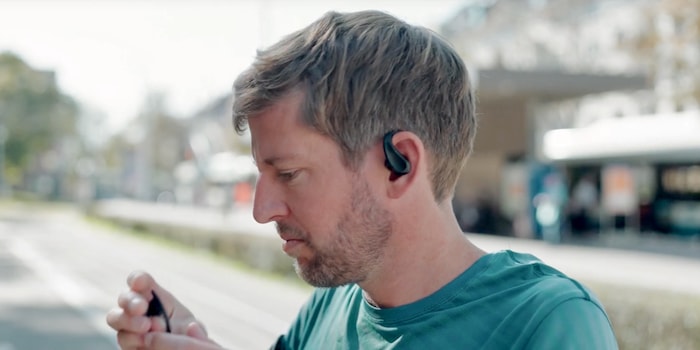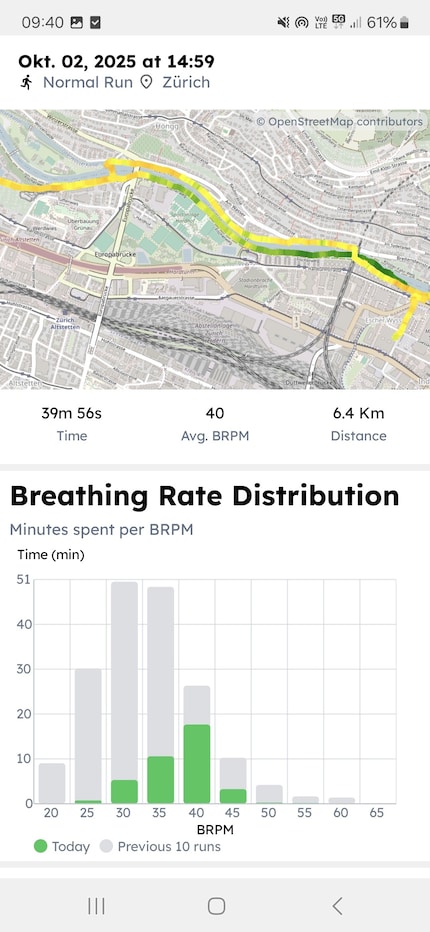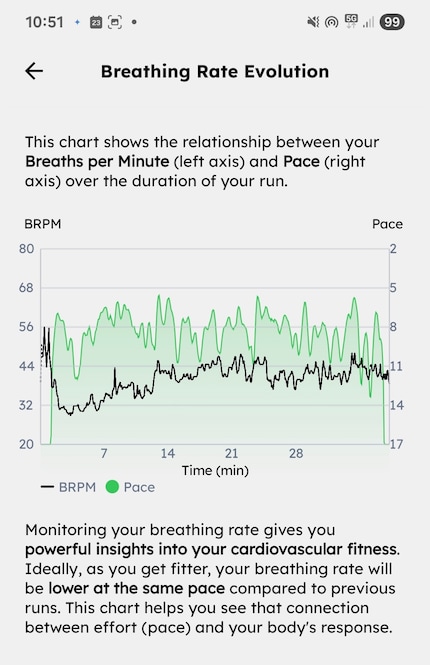
Product test
The Shokz Open Run Pro 2: deeper bass for motivation on runs
by Siri Schubert

Listen to music and record your breathing at the same time? The start-up Breezelabs from Zurich wants to measure the lactate threshold with standard sports headphones.
Matthias Heuberger is a passionate runner. And like many other ambitious amateur athletes, he wears a sports watch during training. But he wants to leave it at home in future.
Because the watch started to frustrate him some time ago. «He complains that it doesn't show the workload correctly, especially during short intervals». Sports watches usually measure the heart rate to track the exertion. However, the heart rate reacts very slowly to rapid changes in intensity. The stress analysis is therefore not entirely reliable in these cases.
I know this from my own experience during hill sprints: I'm panting like a walrus and my tongue feels like it's hanging from my knees. Nevertheless, my sports watch classifies the training as a recovery run. And then perhaps suggests a tempo run the next day.
This is not only annoying, but can also hinder training progress. «Many ambitious amateur runners train too intensively», says Matthias. The result is fatigue instead of increased fitness,
This gave rise to the idea for the start-up Breezelabs.ai, a spin-off from ETH Zurich. The aim is to give athletes a way to precisely measure and control their training intensity. In order to achieve sporting success.
The measurement works with the help of devices that many runners have with them anyway: headphones and an app on their smartphone (so far only on Android). The Breeze tracking app uses the headphones' microphone to record breathing sounds and analyses them using an algorithm.
Avoiding overexertion is one thing. The other topic that Breezelabs focuses on is variety in running training. «Many people always jog at the same pace, which is also not ideal for training progress», says company founder Matthias.
According to the company, Breezelabs.ai currently works with the following Shokz headphones:
And the Xiaomi Redmi Buds 6 Active:
The Breezelabs app can be downloaded via the app store and is currently free of charge. According to Breezelabs, the range of compatible headphones is constantly being expanded.
I tried the app with the Shokz Open Run Pro and could see how my breathing rate changed on the run. I tried to add variety to my training by alternating between easy and more intense sections. The different colours in the app display show the pattern.
The app also gives me insights into the relationship between speed and breathing rate. If I take fewer breaths at the same speed in future, I will have become fitter.
I can tell whether I'm exerting myself more or less, even without the app. But it gets exciting when I use Breezelabs.ai for a so-called «graded run», i.e. a performance test. This is to determine the ventilatory threshold values that mark the transition from aerobic to anaerobic metabolism. These values are usually tested in the laboratory and help to determine the individual training zones. Many runners know these key values as «Zone 2» and lactate threshold.
The start-up won a «Brandnew» award in the Sportstech category at ISPO 2024. Breezelabs is also working with the University of Basel via Innosuisse as part of a doctoral thesis.
For me, the Breezelab app is another tool to better control my training, especially when the training recommendations based on heart rate measurement don't match the perceived exertion. For example, when I feel more tired after intensive intervals than I should be according to the sports watch.
Research diver, outdoor guide and SUP instructor – I love being in, on and around water. Lakes, rivers and the ocean are my playgrounds. For a change of perspective, I look at the world from above while trail running or flying drones.
Interesting facts about products, behind-the-scenes looks at manufacturers and deep-dives on interesting people.
Show allFrom his previous employees at ETH Zurich, Matthias knew that breathing could be measured using a microphone. Breathing is one of the central vital functions, yet it has so far played a rather subordinate role in training control. Researchers have therefore already called the respiratory rate «the neglected physiological variable».



I'm curious to see how the app develops in the future - a solution for the iPhone would be desirable. Additional analysis tools and background information on breathing rate could also provide added value, especially for ambitious athletes who want to optimise their preparation for competitions and are balancing on the fine line between optimal training and overtraining. The app doesn't replace the sports watch for me, but I find it useful for additional insights.